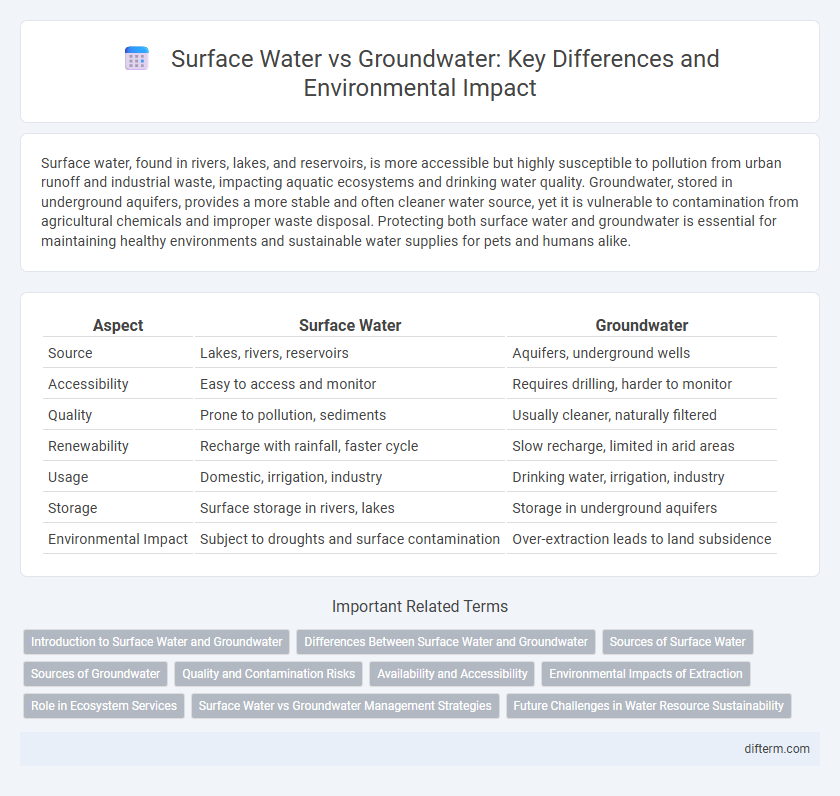Surface water, found in rivers, lakes, and reservoirs, is more accessible but highly susceptible to pollution from urban runoff and industrial waste, impacting aquatic ecosystems and drinking water quality. Groundwater, stored in underground aquifers, provides a more stable and often cleaner water source, yet it is vulnerable to contamination from agricultural chemicals and improper waste disposal. Protecting both surface water and groundwater is essential for maintaining healthy environments and sustainable water supplies for pets and humans alike.
Table of Comparison
| Aspect | Surface Water | Groundwater |
|---|---|---|
| Source | Lakes, rivers, reservoirs | Aquifers, underground wells |
| Accessibility | Easy to access and monitor | Requires drilling, harder to monitor |
| Quality | Prone to pollution, sediments | Usually cleaner, naturally filtered |
| Renewability | Recharge with rainfall, faster cycle | Slow recharge, limited in arid areas |
| Usage | Domestic, irrigation, industry | Drinking water, irrigation, industry |
| Storage | Surface storage in rivers, lakes | Storage in underground aquifers |
| Environmental Impact | Subject to droughts and surface contamination | Over-extraction leads to land subsidence |
Introduction to Surface Water and Groundwater
Surface water, derived from precipitation, rivers, lakes, and reservoirs, plays a crucial role in supplying ecosystems, agriculture, and human consumption. Groundwater exists beneath the earth's surface in aquifers, providing a significant source of freshwater often tapped through wells. Understanding the dynamics between surface water and groundwater is essential for sustainable water management and environmental conservation.
Differences Between Surface Water and Groundwater
Surface water is found in rivers, lakes, and reservoirs, exposed to atmospheric conditions, making it more susceptible to pollution and evaporation, while groundwater resides in underground aquifers, shielded from surface contaminants and less prone to evaporation. Surface water typically responds quickly to precipitation events due to its direct exposure, whereas groundwater recharge occurs gradually through soil infiltration, affecting its availability during droughts. The chemical composition often varies, with surface water having higher oxygen levels and more biological activity compared to nutrient-rich but oxygen-poor groundwater.
Sources of Surface Water
Surface water primarily originates from precipitation, such as rain and snowmelt, which collects in rivers, lakes, and reservoirs. Runoff from urban areas and natural landscapes contributes significantly to surface water availability, influencing water quality and volume. Watersheds and catchment areas serve as critical zones where surface water is gathered and channeled into larger bodies, supporting ecosystems and human consumption.
Sources of Groundwater
Groundwater primarily originates from precipitation that infiltrates the soil and percolates through rock layers, collecting in aquifers beneath the Earth's surface. Key sources include infiltration from rivers, lakes, and surface water bodies, as well as recharge zones where water seeps deep into permeable geological formations. Understanding these sources is essential for sustainable water management and protecting ecosystems that depend on groundwater supplies.
Quality and Contamination Risks
Surface water is more vulnerable to contamination from agricultural runoff, industrial discharges, and urban pollutants, resulting in higher levels of nutrients, pathogens, and chemical toxins. Groundwater generally exhibits better natural filtration through soil and rock layers, leading to improved quality but is susceptible to long-term contamination from sources like leaking landfills, septic systems, and pesticide infiltration. Monitoring for contaminants such as nitrates, heavy metals, and microbial pathogens is critical for assessing the safety of both surface water and groundwater supplies.
Availability and Accessibility
Surface water, such as rivers, lakes, and reservoirs, is often more accessible but subject to seasonal variability and contamination risks, affecting its availability for drinking, irrigation, and industrial use. Groundwater, stored in aquifers beneath the earth's surface, generally provides a more reliable, year-round water source but requires specialized wells and pumping technology for extraction, impacting accessibility. Sustainable management of both surface water and groundwater resources is crucial to balance demand, prevent overexploitation, and maintain ecosystem health.
Environmental Impacts of Extraction
Surface water extraction significantly alters aquatic ecosystems by reducing habitat availability and disrupting natural flow regimes, leading to loss of biodiversity. Groundwater extraction can cause land subsidence, reduced water quality, and depletion of aquifers, impacting both terrestrial and aquatic environments. Over-extraction from either source intensifies environmental stress, exacerbating water scarcity and threatening ecosystem resilience.
Role in Ecosystem Services
Surface water supports diverse ecosystems by providing habitats for aquatic species and facilitating nutrient cycling, crucial for maintaining biodiversity. Groundwater sustains plant life during dry periods by supplying consistent moisture, enabling terrestrial ecosystems to thrive. Both water sources regulate water quality and availability, essential for ecosystem resilience and human consumption.
Surface Water vs Groundwater Management Strategies
Surface water management strategies prioritize controlling runoff, enhancing reservoir capacity, and restoring wetlands to improve water quality and availability. Groundwater management focuses on monitoring aquifer levels, regulating well drilling, and promoting recharge techniques like artificial infiltration. Integrating both approaches ensures sustainable water resource management and resilience against droughts and contamination.
Future Challenges in Water Resource Sustainability
Surface water sources, such as rivers and lakes, face increasing threats from pollution, climate variability, and over-extraction, jeopardizing future water availability for ecosystems and human use. Groundwater depletion rates are accelerating due to excessive withdrawal, particularly in arid regions, causing lowered water tables and reduced natural recharge capacity. Sustainable water management strategies must integrate advanced monitoring, efficient usage, and protection of both surface and groundwater to mitigate long-term scarcity risks.
surface water vs groundwater Infographic

 difterm.com
difterm.com